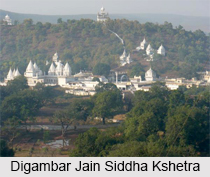 Digambar Jain Siddha Kshetra which is also known as Shri Digambar Jain Siddha Kshetra is one of the most important pilgrimage destination among the Jains.
Digambar Jain Siddha Kshetra which is also known as Shri Digambar Jain Siddha Kshetra is one of the most important pilgrimage destination among the Jains.
Location of Digambar Jain Siddha Kshetra
Digambar Jain Siddha Kshetra is located in Rajgir in Bihar.
Importance of Digambar Jain Siddha Kshetra
Digambar Jain Siddha Kshetra is Siddha Kshetra that is the place of salvation. Rajgir just 15 kms from Nalanda is located the complex of temples and monasteries. Rajgir was the capital of the Magadh Mahajanpad (State) when Patliputra was not formed.
Hills in Digambar Jain Siddha Kshetra
There are five hills located in Rajgir. These are Vipulachala, Ratnagiri, Udaigiri, Arungiri (Swarngiri) and Vaibhavgiri. Many ascetic saints have attuned salvation here. Jivandhara, Swet Sundarva, Vaishakha, Vidyuchchara, Gandhamadana, Panch Pahadi, Dhandatta are famous among them. This place is thus regarded as a Siddha Kshetra. Lord Mahavira also resided here during the four months of rainy season. After he attained Kevalgyan his first Samavsharan was also established here. He delivered his first precept here. Indrabhooti Gautam along with his 500 disciples came here to become Lord Mahavira`s disciple. He became the first and principal Gandhara of Mahavira. Gautama Buddha, the founder of Buddha Dharma (Religion) also visited this place several times with his Sangha. Rajgrahi is also the place of faith for Hindus, Sikhs, Muslims, Christians, Bauddhas.
Temple of Digambar Jain Siddha Kshetra
The temples at Digambar Jain Siddha Kshetra are very ancient and are have been magnificently decorated with sky high spires. There are ten temples located here on the hills and two are situated in the valley. The first hill is known as Vipulachala. There are four magnificent temples established here. A huge and attractive monument has been built here in memory of Bhagwan Muni Suvratnath. On the next hill, Udaigiri two temples are present. These temples were discovered while digging the place. Idols were also recovered from here and have been installed in Lal Mandir situated in valley. The fourth hill known as Swarnagiri can be reached through a valley. There are three temples here. While one comes down to go to fifth hill, a Cave named Sonbhandar Gufa comes in the path. In this cave Jain idols are carved on the walls. The last hill is known as Vaibhavgiri. Five temples are located here. A huge ancient Jain temple has been recovered from here after digging 24 rooms. It is about 1200 years old and many ancient artistic idols are installed here. Apart from these a pair of feet images of Ganadhar Bhagwan is located about at a distance of 1.5 Kms of the last hill. In the valley, ruins of palaces of King Shrenik can also be seen. . Devotees can also visit two magnificent temples located underneath the hill the magnificent temples are adorned with beautifully decorated sky high pinnacles. Many attractive idols of Jain Tirthankaras are installed in the beautiful altars of these temples.
Tourism in Digambar Jain Siddha Kshetra
Digambar Jain Siddha Kshetra being situated on hills is surrounded by scenic beauty that mesmerizes the pilgrims. Many ponds are also situated here that bear naturally hot water. Pilgrims can even take bath here. There are provisions for dharamshalas or rest houses also.
Visiting Information
Digambar Jain Siddha Kshetra is well connected to rail, road, and air. Buses and taxies are available from Patna, Gaya, Nalanda and Bihar Sharif. Rajgir is the last station on Babhtyarpur - Rajgir line i.e. 1 Km. ahead from the Digambar Jain Siddha Kshetra. The nearest airport of Digambar Jain Siddha Kshetra is located in Patna at a distance of 100 Kilometres from here.




















